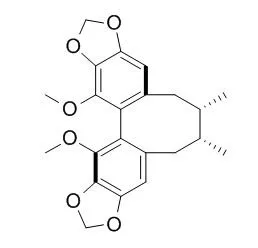| Cell Research: |
| Cell Biol Int. 2015 Dec;39(12):1418-24. | | Protection of seven dibenzocyclooctadiene lignans from Schisandra chinensis against serum and glucose deprivation injury in SH-SY5Y cells.[Pubmed: 26289388 ] | Dibenzocyclooctadiene lignans, the major active components of fruit of Schisandra chinensis (Turcz.) Baill., have been found to have activities that could prevent prostate and thyroid cancer, hepatotoxicity, oxidative stress-induced cerebral injury, etc. This study was conducted to evaluate the effects of seven dibenzocyclooctadiene lignans of Schisandra chinensis and explore the possible mechanisms in the human neuroblastoma SH-SY5Y cells exposed on serum and glucose deprivation (SGD) injury. The structure-activity relationships were also analyzed.
METHODS AND RESULTS:
Cell viability and lactate dehydrogenase (LDH) release were determined to evaluate cell injury. Inflammation and apoptosis-related protein levels were detected to elucidate the possible mechanisms. Schisantherin A, Schizandrin C, and schizandrol B were found to have stronger protective effects than schizandrin A, schizandrin B, and schisanhenol in SH-SY5Y cells against SGD injury. Moreover, the protective effects of these lignans were possibly exhibited by regulating inflammation and apoptosis-related proteins in SH-SY5Y cells after SGD injury, supporting their beneficial effects for the prevention of cell injury in the pathogenesis of the central nervous system diseases, including ischemia stroke.
CONCLUSIONS:
The number and position of hydroxyl group and methylenedioxy in these lignans may be required for their effects. |
|
| Structure Identification: |
| Zhongguo Zhong Yao Za Zhi. 2018 May;43(10):2104-2111. | | Simultaneous determination of lignans and organic acids in Schisandrae Chinensis Fructus by UFLC-Q-TRAP-MS/MS.[Pubmed: 29933678] |
METHODS AND RESULTS:
An analytical method based on UFLC-QTRAP-MS/MS was developed for simultaneous determination of fifteen components including eleven lignans (schizantherin B, schisandrol B, Schizandrin C, γ-schisandrin, deoxyschizandrin, schisantherin, schisandrin, schisanhenol, gomisin D, gomisin J, and angeloylgomisin H) and organic acids (S)-malic acid, D(-)-tartaric acid, protocatechuic acid, and quinic acid) in Schisandrae Chinensis Fructus. Samples from different product specifications were evaluated and analyzed. The chromatographic separation was performed on a Synergi™ Hydro-RP 100Å column (2.0 mm×100 mm, 2.5 μm) at 40 °C with a gradient elution by employing 0.1% aqueous formic acid (A)-acetonitrile (B) as the mobile phase, and the flow rate was 0.4 mL·min⁻1, using an electrospray ionization (ESI) source and multiple reaction monitoring (MRM) mode. Fifteen components were evaluated synthetically by TOPSIS and gray related degree. The results showed that fifteen components had good linearity (r>0.999 90), and the limits of detection were all satisfactory. The average recoveries of standard addition for the compounds were between 95.42 % and 98.86 %, and the relative standard deviations were less than 5%. The greatest difference of ri in grey related degree was 58.1%, whilst the greatest difference of Ci value in TOPSIS method was 94.8%. The results of these two methods showed that the holistic quality of No. 14 sample was the best.
CONCLUSIONS:
The developed method was accurate and reliable, which was suitable for the simultaneous determination of multiple functional substances and able to provide a new basis for the comprehensive assessment and overall control of the quality of Schisandrae Chinensis Fructus. |
|






 Cell. 2018 Jan 11;172(1-2):249-261.e12. doi: 10.1016/j.cell.2017.12.019.IF=36.216(2019)
Cell. 2018 Jan 11;172(1-2):249-261.e12. doi: 10.1016/j.cell.2017.12.019.IF=36.216(2019) Cell Metab. 2020 Mar 3;31(3):534-548.e5. doi: 10.1016/j.cmet.2020.01.002.IF=22.415(2019)
Cell Metab. 2020 Mar 3;31(3):534-548.e5. doi: 10.1016/j.cmet.2020.01.002.IF=22.415(2019) Mol Cell. 2017 Nov 16;68(4):673-685.e6. doi: 10.1016/j.molcel.2017.10.022.IF=14.548(2019)
Mol Cell. 2017 Nov 16;68(4):673-685.e6. doi: 10.1016/j.molcel.2017.10.022.IF=14.548(2019)